Executive Summary
Business is booming for US retailers. Unemployment is low, as are interest rates and inflation, and wages are up. All in all the perfect recipe for retail success. Consumers have money and they’re not afraid to spend it.
But the market is competitive. Not only do small retailers need to compete with the chain stores and Amazon, they also need to compete with each other.
With such intense competition, both online and offline, it’s more important than ever for small-to-medium retailers to know how they’re performing relative to their competition.

Armed with the information in this report, retailers can take proactive steps to grow their businesses in this thriving environment and beat their competition.
Become conducted a report using data from over 2,000 retailers across the U.S. over a two-year period (2017-2019) to give retailers insight into their industry. How does your business measure up?
A key indicator of business performance is monthly revenue. But it’s also important to look at other factors such as cash flow and credit score.
With so many types of retailers across 50 U.S. states, it’s not accurate to simply lump all retail businesses together. For this reason, in this report, we’ve segmented our study and broken it down based on multiple factors, including retailer type and location.
Retail Report Key Findings
According to the data that Become collected from over 2,000 US businesses, it looks like retailers aren’t doing too badly! The statistics also reveal some unexpected surprises.
Which is the Best State for US Retailers?
Surprisingly, Colorado, Arizona and Florida are the top 3 US states for retailers in terms of average monthly revenue.
Below you’ll find a USA map indicating the average monthly revenue of retailers per state. This can help retailers assess the revenue earning potential in their state.
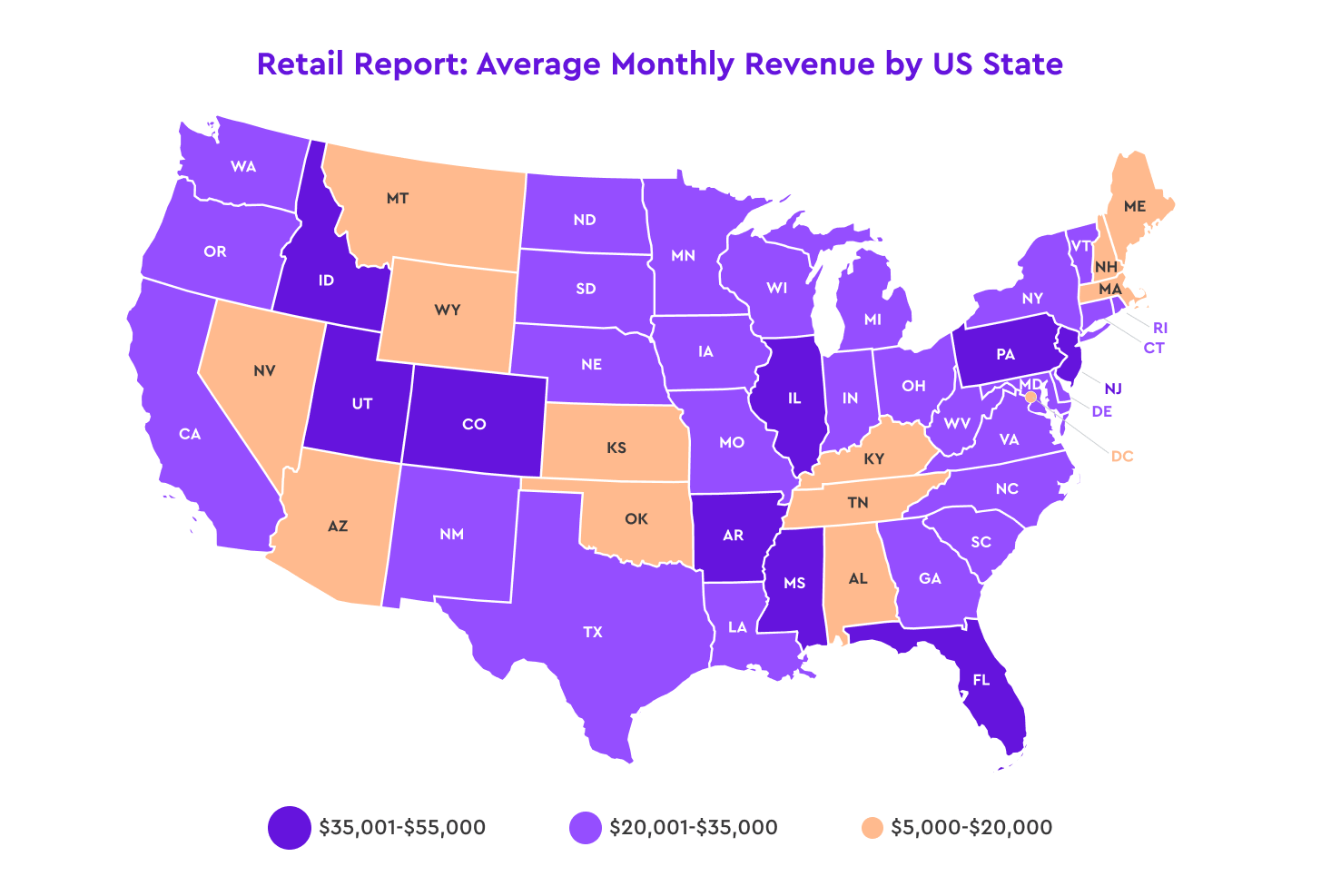
And the top 6 states by revenue…

It’s interesting to note that Colorado and Arizona surpassed even California and New York.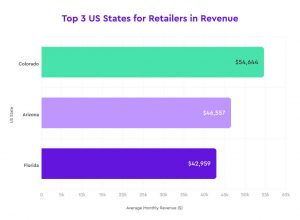
The average monthly revenue for businesses in Colorado is $54,644. This state is an attractive place in general to start a small business and came in at ninth place in CNBC’s 2019 America’s Top States for Business, which ranked states based on across 10 broad categories including: economy, workforce, cost of doing business, infrastructure and more.
The top types of retailers in Colorado based on average monthly revenue are: 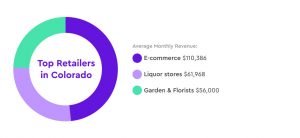
The average monthly revenue in Arizona is $46,557 with the top retailer types being: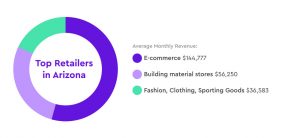
In Florida, the average monthly revenue for retailers is $42,959. Top retail performers are:
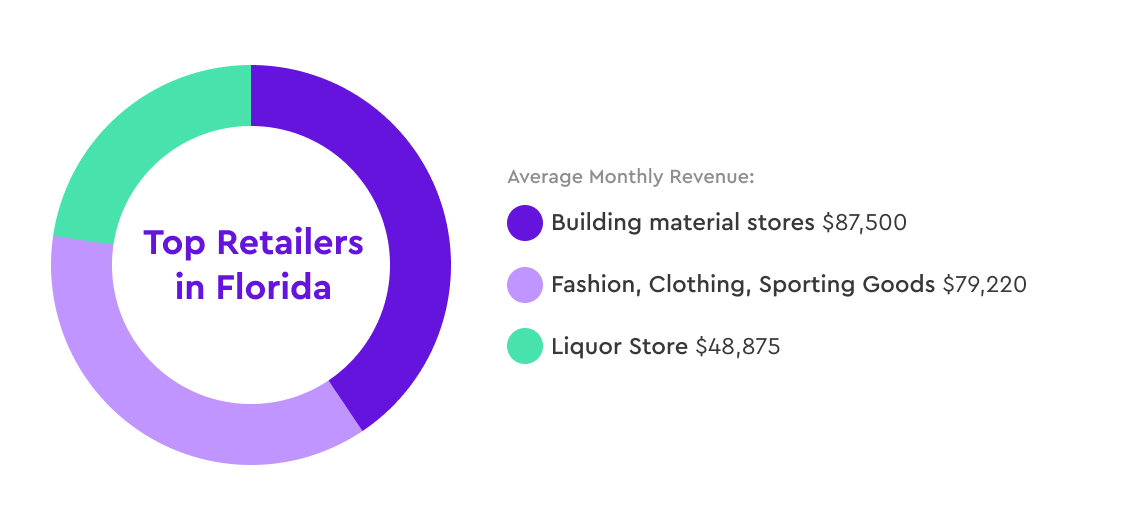
You’ll notice that e-commerce is the industry leader in both Colorado and Arizona, but doesn’t feature in the top 3 retail types in Florida.
What are the Best Retail Types in the US?
Based on the Become study, 39.44% of US retailers are fashion, clothing, sports stores, 27.12% are e-commerce businesses and 11.15% are groceries, supermarkets and bakeries.
This indicates that although online shopping is growing, consumers still enjoy the in-store experience, particularly when it comes to trying on clothing. To optimize retail sales, a retailer could sell both online and in-store.
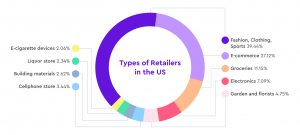
Which Retailers Earn the Highest Revenue?
Nationwide, Grocery, Supermarkets and Bakeries earn the highest monthly revenue at $40,122. This is followed by E-commerce ($31,313), and then Fashion, Clothing, Sports Goods ($27,744). Grocery stores rely on volume to make money, as the profit margins are very low, ranging from one to three percent. 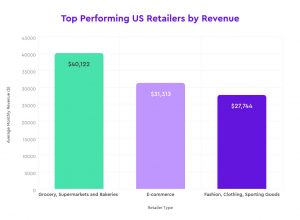
We might expect the gap between e-commerce and traditional retail channels for fashion, clothing and sporting goods to increase as more and more shoppers spend online, but industry trends tell a different story.
Setting The Scene: Retail Industry Trends & Stats
A New Era of Retail
Retail has gone through many changes over the past decade, with the advent of the internet and technology. Not only have retail channels, processes and payment methods changed, but customer expectations have changed along with it. So to succeed as a retailer, it’s not enough to rely on old tried-and-tested methods – those who do not evolve do not survive.
Retail’s Booming, Not Just E-Commerce
Despite all the chain store closures of early 2019, retail is on the upswing. According to the National Retail Federation (NRF), for every company that closes stores 5.2 are actually opening new stores.
In February 2019, the NRF predicted that US retail sales would increase by 3.8%-4.4% in 2019, exceeding the $3.8 trillion mark. The increase could be attributed to high consumer confidence, an improvement in wages and low unemployment rates in the US.
The alleged ‘retail apocalypse’ punted by the US Retail Census Data does not paint the full picture, based on the NRF’s report. E-commerce and instore are not mutually exclusive and should not be separated as such. Based on a JLL Research report, it’s estimated that 850 physical stores will be opened by ecommerce stores over the next 5 years. There’s significant overlap between online and physical retail which cannot be ignored.
Even Amazon has realized the importance of a physical storefront and creating a memorable customer experience, and as a result opened up Amazon Go.
Nearly 12.5% of all US retail sales will be online by 2020. Almost 70% of Millennials prefer to shop online, so if you’re not selling online as well as in store, then you’re missing out on a large and influential consumer base. And let’s not ignore mobile. According to data provided by Pew Research, over 80% of Americans own a smartphone.
It’s clear that a blended approach is the way of the future. For small retailers, it is essential to differentiate and maintain their niche, while at the same time opening up new consumer channels by going online. And online stores should consider opening up a physical storefront, thus approaching customers from all angles.
David vs Goliath in Retail
Surprisingly, 98.6% of all US retail businesses are small retailers with less than 50 employees. According to SCORE, Amazon is accountable for a mere 5% of all US retail sales so clearly even small mom-and-pop stores have something unique to offer that even Amazon cannot compete with.
Tips for retailers on how to compete with Amazon:
- Create an exceptional instore experience. Shopping has become more experiential than just transactional. For example, if you own a toy store, don’t just sell toys. Create a place where children can play, learn and explore – arts and craft tables, or a place to experience the toys are just some ideas. ‘Retailtainment’ has become increasingly popular – these retail events engage customers in a way that they cannot experience with an online purchase.
- Offer unique products. If you sell one-of-a-kind items, then customers will have a reason to shop in your store instead of buying a mass-produced item from Amazon
- Become a third-party Amazon seller. If you can’t beat ‘em, join ‘em. According to Amazon’s 2018 Small Business Impact Report, half of all items sold on Amazon in 2018 were from third-party retailers. As Become’s data has revealed, e-commerce is the second top revenue earner in the retail space. Even if you don’t currently sell online, you could set up an e-commerce site and sell through Amazon, as well as directly to customers.
Now that you know you’re in this niche that has the capability to offer what Amazon cannot, need to make sure you remain competitive amongst your competitors – your fellow small retailers. The first step to beat your competition is to know how they’re performing.
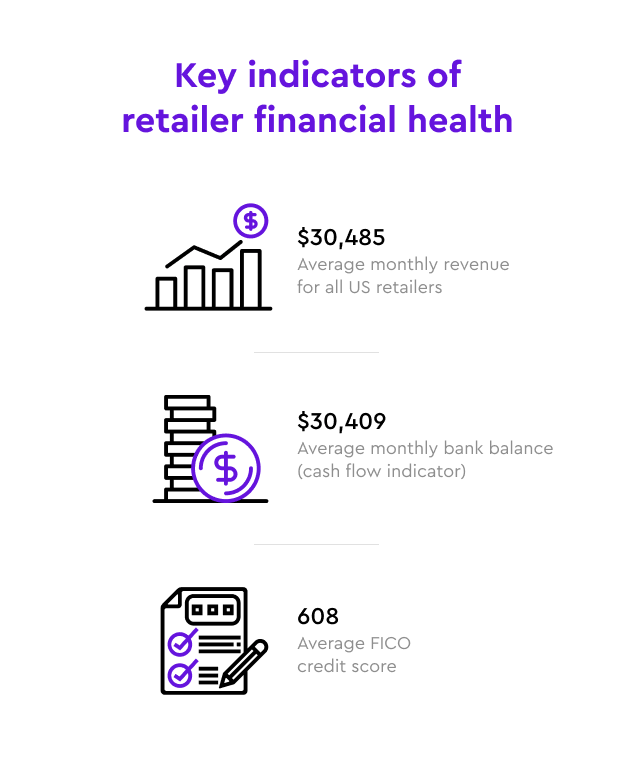
Key measurements of a retail business’s health are:
- Monthly revenue
- Cash flow (measured by bank balance)
- Credit score
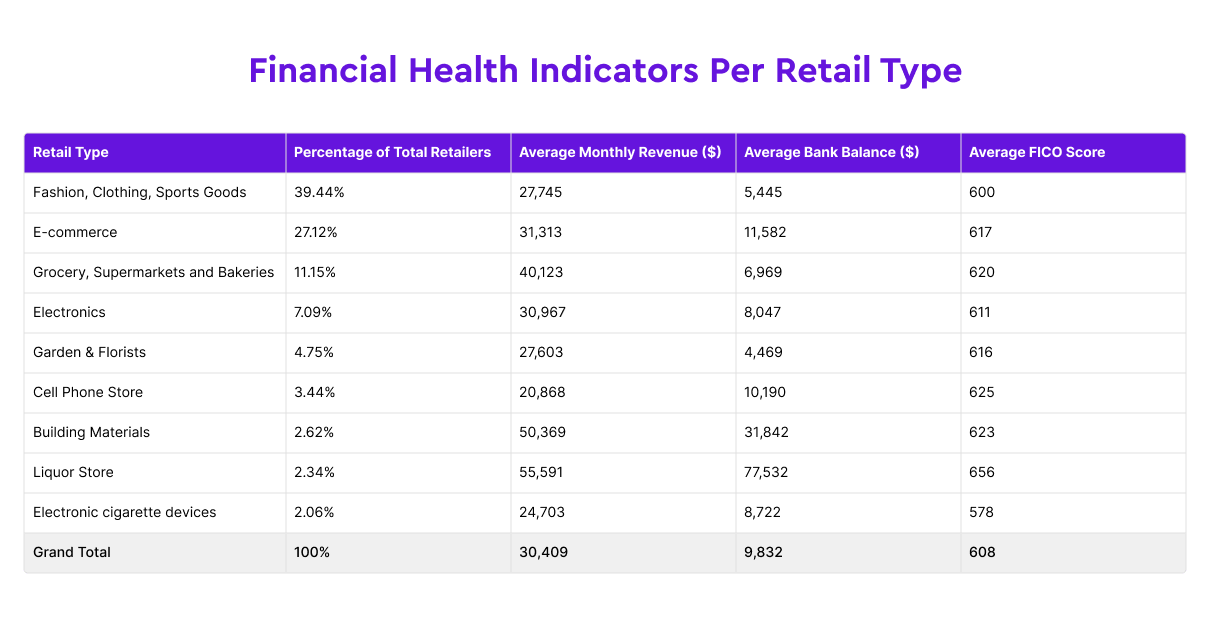
In terms of business health, liquor stores appear to perform well – they have the highest monthly revenue, bank account balance and credit score. This is interesting as a liquor store isn’t generally considered a cash cow. Next in line are building material stores, which also generally perform well on these three criteria.
If you can improve your business’s monthly revenue, cash flow and credit score, you’re likely to become a healthy retail business, well-positioned against your competition.
How to Improve Your Business’s Monthly Revenue
1. Increase your number of customers
Be it trying to bring more customers through the door of your store or more traffic to your website, increasing your numbers can increase your profits but how do you do this? This depends on your industry but it boils down to ‘you have to spend money to make money’. Be it jazzing up your store and serving higher quality products or investing in some paid ads for your social media to gain more exposure (and ultimately leads and customers).
Tips to increase your customer base:
- Build up your social media presence – open up many channels (Facebook, Twitter, LinkedIn, Instagram) and invest some money in paid ads.
- Email marketing – use this to send out promotions, events, newsletters, and new products. Make sure they look professional, are mobile-friendly and that they are fully optimized. You could use MailChimp to add a professional spin on things.
- Refer-a-friend programs – offer discounts to those customers who refer a friend.
2. Increase your average transaction size
Your goal is to try and make each and every customer purchase more, otherwise known as ‘upselling’. Going back to the store example, if a customer comes in and buys jeans, upselling would mean offering them shoes, a top and an accessory – the more they purchase the merrier.
Tactics to upsell include:
- Stick with a few well-targeted recommendations to maximize your chances of a successful sale. If you are selling a product online, for example, a ‘recommended for you’ section or ‘similar products you may like’ with two or three items could work well.
- Try bundling – packaging items together into a bundle package deal rather than standalone items is a great way to upsell.
- Know the 25% upsell rule – it’s good practice to not try and upsell items or services that are 25% more than the original order.
3. Increase purchase frequency
In other words, try to get your customers to purchase from you more often. Just because a customer bought your product or service, doesn’t mean that they will do so again. You need to find a way to keep them coming back for MORE using one or more of these strategies:
- Subscription model – a good strategy that many online retailers in particular are employing is to offer a subscription model. The idea is to get customers to sign up for repeat purchases at set intervals at a discounted price. This is a popular option on Amazon.
- Loyalty programs – provide customers with a members loyalty card whereby after a certain number of purchases, they would get a free or discounted purchase.
- Points system – you could implement a membership program whereby customers earn points based on dollars spent in your store. Once they reach a certain minimum number of points, they can then use them to pay for or subsidize their next purchase.
- Value your customers – if you have a friendly approach they are much more likely to use your services again.
- Use email to build an ongoing relationship (just make sure you don’t spam them senseless with irrelevant emails that could only harm your reputation). It’s a good idea to send out personal messages or emails on a customer’s birthday, for example, to foster a stronger relationship.
4. Raise your prices
Doing this will mean that you’re able to collect more revenue from your purchases giving you more revenue for the same amount of effort. This is a game of push and pull, where you’ll have to learn from your customers where the boundary lies. You don’t want to hike up your prices so much that it’ll make your customers go running, but rather a small increase to see if you meet resistance.
Find your point of resistance:
If you slightly up your prices and none of your customers so much as bat an eyelid then you know you are in the safety zone. You can try doing this every few months to find where you meet resistance – where customers either complain or the stats show they are dropping off. For this reason, you should only ever change your prices subtly. When you find the ‘point of resistance’ so to speak, you’ll know you need to lower them a notch and you’ve found your happy balance.
How to Improve Your Business’s Cash Flow
Knowing how to manage your business’s cash flow is extremely important for keeping your financials in check and allowing your business to evolve. If you’re noticing lags between the times that you have to pay your bills, suppliers, and employees and the time you collect the cash from your customers, then you’re not alone. Knowing how to manage your cash flow, be it by delaying the spending of cash, or speeding up your incoming payments is something that every successful business must learn to do effectively if they wish to survive (and hopefully thrive!).
Here we’ll detail how to manage your cash flow efficiently to improve your finances…
Measure
Before we get to improving your cash flow, you’re going to need to know exactly what you have to deal with. You’ll need to make a good forecast for the foreseeable future:
- Prepare cash flow projections for the next year or next quarter, and if you’re just starting out or unstable, then shorten this time frame to the next month.
- Make detailed and accurate cash outlay projections – note the amounts and dates of upcoming cash outlays (as well as on what), the more detailed the better.
- Project cash inflow to be expected – this is a little trickier but try to make educated estimates, noting down when and how much.
- Use technology to your advantage – make use of cash flow worksheets and modern invoicing and bookkeeping software such as QuickBooks to give you a helping hand.
Increase Receivables
Your receivables cover the amounts owed to your business, otherwise known as your assets. In an ideal world, you’d get paid for sales the very instant that you make them, but the world isn’t always ideal…
Here are some specific techniques on how you can improve the speed at which you receive your receivables:
- Offer a discount to customers who pay their bills on time or faster than the due date – this is a great incentive for customers, after all, everyone is looking for a way to save money on a product or service.
- Ask customers for a deposit when the order is taken – this can save you from completing your end of the deal and all your hard work going to waste when a customer decides to abruptly cancel an order.
- Make credit checks a must for all new noncash customers.
- Issue invoices speedily and to follow up payments that are slow immediately.
- Track all receivables to better avoid slow-paying customers – consider instituting a cash on delivery (C.O.D) policy rather than refusing to conduct business with them altogether.
- Sell off outdated and old inventory for cash – every little bit helps!
Methodology
This report was created by analyzing the data of over 2,000 small-to-medium retail businesses that applied for funding through Become’s business funding marketplace from 2017 to 2019. These businesses are based across the US.
How Does Your Retail Business Shape Up?
Based on the data provided, how does your business measure up? Follow the tips provided to improve your cash flow, monthly revenue and credit score, and consider going online if you’re a physical store. Keep on top of consumer and industry trends and 2020 may just be your best year yet.
Disclaimer: The information contained in this article is provided for informational purposes only, should not be construed as legal advice on any subject matter and should not be relied upon as such. The author accepts no responsibility for any consequences whatsoever arising from the use of such information.


